by Winding Pathways | May 30, 2024 | (Sub)Urban Homesteading, Mammals, Pests
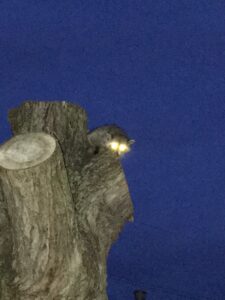
Raccoons are strong and hungry.
A raccoon kerfluffle with loud growling and snarling startled us to nearly jump from our chairs one May evening. It came from an oak tree 20 feet away from the house and close to our bird feeder. A flashlight beam on that pitch-black night revealed the culprits – three young raccoons high in the tree.
They quickly scurried down the tree and scampered out of flashlight range, letting us return to reading. Why was there a young raccoon kerfluffle? We can only guess but we’re certain they were there because of our nearby bird feeder.
What Raccoons Eat
At first glance, raccoons seem to be carnivores. They have sharp meat-eating teeth and look somewhat like a cross between a dog and a cat. Looks are deceiving. Raccoons are amazingly abundant across much of North America, in large part because they are opportunistic omnivores that seem eager to eat almost anything. They love frogs, crayfish, mussels, earthworms, fish, and any unfortunate mouse or vole they can catch. To a raccoon, a garbage can or dumpster is an invitation to dinner where they might discover delicious pizza crusts and an array of other discarded goodies.
Not Just Birds at the Feeder
Raccoons love fruit and grains. We have them in abundance. That is what lured them to our yard. To these cute but powerful animals, a feeder is an after-dark cafe. Most everyone is familiar with the determination squirrels show when attempting to reach even the most inaccessible feeder. Squirrels work feeders on the day shift while raccoons, deer, mice, voles,
skunks, opossums, bears, and flying squirrels often visit after dark when few people are watching.
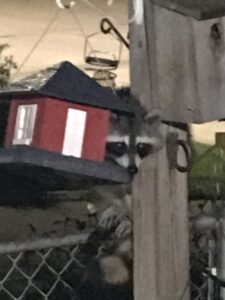
Raccoons are skillful climbers.
At Winding Pathways, we put expensive sunflower seeds in a feeder suspended by a metal hook on a slippery metal pole. It is so high even deer can’t reach it. But since many birds prefer feeding on the ground, we sprinkle cracked corn, millet, and a few sunflower seeds on the ground beneath the high feeder.
Usually, birds clean up all the seeds by sunset, but frequently some remain as darkness approaches. It’s always gone the next morning. Nocturnal mammals did the clean-up work.
After Dark Feeder Watching
Once in a while, we focus a flashlight beam on the feeder after dark. Often the eyes of deer glow back at us, and occasionally we spot other animals enjoying a seed dinner. Usually visiting raccoons eat quietly, but the startling noise we heard that night came from squabbling youngsters.
Adaptable Raccoons
Raccoons are amazingly adaptable. Our son lives in one of the most densely populated cities in the world – Brooklyn, NY. He occasionally sees a raccoon sticking its head up from a dumpster.
They are not just in North America. Raccoons were introduced to Russia to create a fur resource. They also were released in 1934 in Germany and have since spread far and wide and are increasingly common in Ukraine. Many Japanese people imported baby raccoons as pets and released some as they grew large and unruly. Today wild raccoons range through much of that Asian country.
Whether in Russia, Ukraine, or Japan they are exotic, invasive animals causing mischief. Although common in the United States they are native here and sometimes create a mess as they paw through a trash can or raid a chicken coop. However, they’re fascinating and beautiful animals that can often be spotted beneath a feeder in a flashlight beam.
The Nature Conservancy posts an excellent blog called “Seven US Species Invading Other Countries.” Raccoons top the list.
Nightly Adventure Continues
Since that evening, the trio of masked bandits that caused a raccoon kerfuffle have returned. Sometimes, like any siblings, they get along. Other times they disturb the night as they screech, snarl, and growl at each other until we shine a light on them or shoo them off. We can always count on some nocturnal adventure at Winding Pathways.
by Winding Pathways | Feb 22, 2024 | Birds, Mammals, Nature, Pests
We’ve blogged before about a white-footed mouse in the house. We read the story to our kids when they were little. Time after time we snuggled down with the book and they never got tired of hearing why the mouse might be cute but doesn’t belong in the house. A recent internet search for the specific book revealed lots of stories but not the one we wanted. Alas. So, here we are decades later writing again about a mouse in the house. Mice are cute but they do not belong in a house.
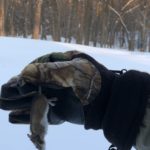
A person holding a mouse.
Whenever we’d find mouse evidence in our house, we’d set traps and usually catch a few, tossing their lifeless bodies outside for scavenger animals to eat. We do feel badly, but as the mother in the story said, “…a mouse does not belong in a house.”

Path to the outdoor pantry
In January we changed our mind…..sort of. It was 20 below zero outside. Rich trudged through snow drifts to fill our bird feeders and noticed tracks, tiny mouse tracks, in the snow. A crafty white-footed mouse had scampered on top of the snow the night before to scrounge a few leftover seeds for dinner. Its tracks led to a snug nook out of the wind and under the deck.
An average White-footed mouse weighs a whopping .7 ounce. That’s seven-tenths of an ounce! That such a tiny creature can survive the howling wind and intense cold is a marvel of nature. Every nocturnal predator from coyotes to owls tries to capture and eat this diminutive mammal. But, it is wily, wary, and quick. Although not usually out during the day, it has to be mindful of cats and hawks looking for a meal.
-
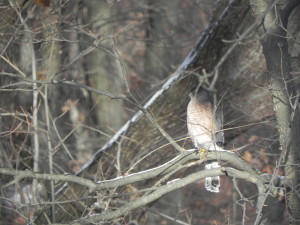
-
Patience
-
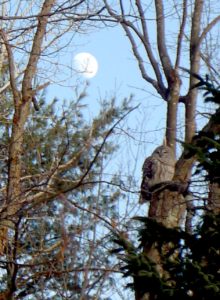
-
Nocturnal predator
After seeing those tracks, we felt a bit sorry for the animal that made them. We still won’t welcome a mouse into our house, but we’re happy it lives just outside in a safe place under the deck. He’s welcome to any seeds the birds overlooked.
To learn more about White Footed Mice and many other wild animals check out Animal Diversity Web out of the University of Michigan.
by Winding Pathways | Nov 9, 2023 | (Sub)Urban Homesteading, Mammals, Nature
Update on Furless Tailed Squirrels
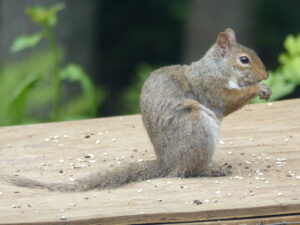
Even in winter, the squirrels’ fur looks healthy…except for their tails.
Two winters ago, we noticed squirrels with nearly furless tails visiting our bird feeders. Our blog about them on Winding Pathways brought hundreds of visitors. Some from other countries! Apparently, we weren’t the only people seeing these hapless animals.
Last winter we had almost no squirrels in the yard. We wonder if the malady that caused them to lose tail fur might have knocked their population way back.
This fall we’re seeing plenty of both fox and gray squirrels in our yard. Their populations have rebounded. And, they have long, furry tails! Squirrels make us happy. While many people don’t like them gobbling seeds at the feeder, we are OK with that and find them as fascinating and fun as cardinals, chickadees, and goldfinches.
Squirrels and the Derecho
Now three years since the disastrous derecho that felled thousands of trees in the Eastern Iowa area, we’re seeing the vital work squirrels do. In the wake of the storm, people planted thousands of trees. Then came three drought years. The National Weather Service placed Cedar Rapids into its exceptional drought category in 2023.
The drought killed many human-planted trees but the ones planted by squirrels are doing just fine. Thanks to them, baby hickories, walnuts, and oaks are poking through the soil in nearby woodlands and our yard.
This fall we’ve watched squirrels carry acorns and walnuts across the yard, dig frantically, and bury their treasure. These enthusiastic gatherers and diggers plan to return during winter’s lean months to retrieve dinner from underground storage. Fortunately, squirrels bury more nuts than they’ll ever need. Unfortunately for them, some of the furry hoarders die with their hidden hoard untouched to sprout in the spring. Squirrels are master tree planters.
-
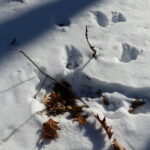
-
Squirrels at work.
-
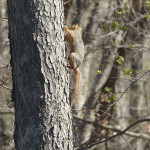
-
What happens when a squirrel falls?
-
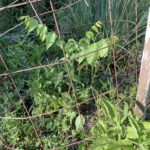
-
This squirrel planted walnut seedling sprouted just this year in spite of the drought.
American Ninjas in the Yard
An oak and a walnut live about 150 feet south of our back deck. Acorns and walnuts are epicurean squirrel delights, and our trees attract the furry acrobats. Squirrels like to use treetops as highways, jumping from one to the next. Our oak and walnut presented them with a problem. There is a several-foot gap between their branch tips. We are fascinated watching the squirrels make the long leap from twig to twig, sometimes leaping up to reach a branch on another tree, often while clutching a nut in its teeth. Their athleticism is astounding. So is their courage.
Squirrels fall. Twice we’ve seen one lose its grip and drop from the top of enormous trees. Both times the furry animals spread eagle their legs and tails while descending and hit the ground with a thump. They are shaken, rest, and then scamper off. A fall that would instantly kill a person, is hardly phased by the squirrels.
This winter we’ll again welcome squirrels to our feeders. They can dine on whole or cracked corn and cobs. We are assured of entertainment with their romps, athleticism and enthusiasm.
-
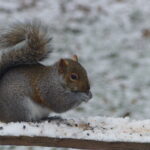
-
Squirrel tails have many uses.
-
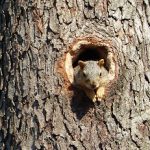
-
It’s a long way down, Mom.
-
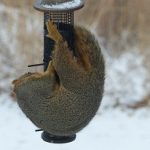
-
Squirrels wolf down seed meant for birds.
by Winding Pathways | Sep 14, 2023 | Mammals, Nature, Travel/Columns
We were recently amazed to learn that Pennsylvania has a thriving herd of wild elk.
A couple of times each year we make the long drive from our Iowa home to visit relatives in New Jersey. We traverse Pennsylvania on Interstate 80. For years we’ve been intrigued by interesting and unusual town names we see on roadside signs. Jersey Shore, Mountain Top, and Snow Shoe are examples.
As we approached mid-Pennsylvania recently heading back to Iowa, we tired of the big semi-truck-filled road. So we exited at the tiny town of Snow Shoe and followed smaller paved roads through the forests and clearings of Moshannon State Forest. We soon reached the hamlet of Benezette, the epicenter of Pennsylvania’s wild elk herd.
Thanks to a stop at the visitor center of the Keystone Elk Country Alliance we learned the fascinating story of this massive deer’s return to an area called the Pennsylvania Wilds.
Where Elk Once Trod
When Columbus made landfall wild elk roamed much of what became the United States, even close to the Atlantic Ocean’s shore. Such tasty and large animals had little chance against explosive human population growth and the conversion of wild lands to farms, ranches, roads, and urban areas. By the late 1800s wild elk only lived in wild areas in the Rocky Mountain States.
Fortunately, that’s changed. Now there are wild elk herds in at least 19 states, including Michigan, Minnesota, West Virginia, Missouri, Arkansas, and North Carolina. Kentucky has the largest wild elk herd east of the Rockies with at least 13,000 of the massive deer roaming the state.
How It Happened
In 1912 a shipment of elk was trained from Yellowstone National Park to Pennsylvania and released in the north-central part of the state. It was joined by some animals from a private herd and further releases a few years later. The herd stayed small for years but began expanding during the past few decades. Today about 1,400 wild elk roam the area.
We loved our day in the Benezette area. The lands are managed so large patches of open woods allow visitors to see into the forests hoping to spot elk. It was hot, so the elk were somewhere deep in the shady woods. We didn’t see any but enjoyed learning more in the impressive museum. Then, we walked area trails looking for signs of elk – droppings, and rubs. Hot and thirsty, we stopped at the Elk Life Store for elk hot dogs and a cool beverage. Tasty and with great views. The hills shimmered in the light and streams coursed down the draws and valleys.
Elk bring tourists to the Benezette area. Small lodges, bed and breakfasts, and Airbnb’s abound. The most popular time is fall when male, or bull, elk bugle. Make lodging reservations well in advance. For information contact Keystone Elk Country Alliance.
-

-
The Keystone Elk Country Land is a cooperative among agencies.
-

-
Gracing the entry
-

-
We enjoyed an elk dog and beverage.
-

-
Rolling hills and small shops characterize Elk Country.
Pennsylvania’s Not Alone
Thanks to the efforts of state wildlife agencies, the Rocky Mountain Elk Foundation, volunteers, and financial donors elk are thriving in many states. Read where elk live. And, for a map, check out the Izaak Walton League’s site.
We even have about 15 elk in Iowa. They’re at the Neal Smith National Wildlife Refuge near Prairie City east of Des Moines.
A trip to Wyoming, Colorado, or Idaho offers wonderful chances to see elk, but elk can be seen far and wide across the Eastern United States.
by Winding Pathways | Aug 10, 2023 | Mammals, Nature, Trees/Shrubs
Squirrels: Free Tree Planters
Our neighborhood squirrels proved they are the best tree planters.
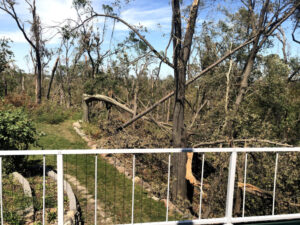
We lost most of our mature trees in the 2020 Derecho.
An August 2020 derecho tore through Iowa pushing 140-mile-an-hour wind against trees and buildings. Trees by the hundreds of thousands tumbled to the ground. Winding Pathways wasn’t spared. We lost most of our firs, oaks, hickories, and cottonwoods. The devastation in nearby Faulkes Heritage Woods was even worse.
Almost immediately, shocked people took action. Government forestry departments, aided by tree planting nonprofits, and private citizens unleashed their shovels and planted thousands of trees. So did the squirrels. Well, not really. People planted trees.
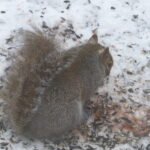
Squirrels bury nuts in caches to retrieve them later.
Squirrels planted nuts and acorns.
Then three seasons of drought followed. Once planted, most trees were not tended as they need to be. So, many human-planted trees shriveled in the heat and dryness, while the nuts buried by squirrels sprouted and the new trees were flourishing.
But why?
We have theories. A human-planted tree seedling needs plenty of moisture to keep its trunk and new leaves hydrated. Sparse roots must pull water from the ground and send it upward. That’s a tough job in a wet year. Come drought it’s nearly impossible.
Squirrels did better. These industrious rodents don’t mean to create new trees. They’re simply storing nuts underground so they have enough fat and protein-rich food to tide them through winter. All they need to do is dig up a nut when hunger calls. Squirrels overfill their larder, burying more tasty nuts than they’ll ever need. Unfortunate squirrels are eaten by hawks, foxes, owls, or humans, but the nuts they’d buried remain patiently waiting for spring’s warmth to germinate.
Sprouting nuts grow roots able to pull scarce moisture from the soil and send it to new baby leaves poking through the ground.
As we walked through July 2023’s dry woods we sadly see human-planted trees shriveled up and dead, while nearby a new generation of tiny walnut, oak, and hickories is rising from nuts planted by industrious squirrels.
-
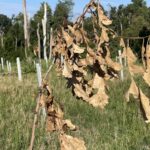
-
Newly planted trees need watering.
-

-
This squirrel planted walnut seedling sprouted just this year in spite of the drought.
Squirrels Don’t Plant All The Trees
Squirrels are the best friends of nut-bearing trees, but other tree species can’t rely on the furry rodents. Cottonwoods, for example, produce millions of seeds too tiny for squirrel food. So, the trees grow cottony fluff that floats seeds to distant places. If one lands in a patch of moist bear soil a fast-growing cottonwood sprouts. Maples have helicopter-like seeds that whirl a gig away from the parent to sprout a ways away.
Pity the poor Osage Orange tree that grows huge citrus-smelling balls containing hidden seeds. Many folks call them hedge apples. A tree must get its seeds away from its own shade. Squirrels do the job for oaks. The wind for cottonwoods. Massive mastodons once munched on Osage Orange hedge apples, wandered off, digested the pulp, and pooped out the seeds. When these massive elephants went extinct the tree lost its partner and saw its native range shrink from much of North America to a tiny spot down south.
Nature provides many ways for trees to reproduce and the results are often superior to what humans can do. We appreciate the squirrels that plant nuts many of which sprout into healthy native trees. Thanks, squirrels!
by Winding Pathways | Jun 22, 2023 | (Sub)Urban Homesteading, Foraging, Mammals, Nature, Pests
Fish Camp Woes
This year a giant bear tore up the Popsie Fish Company’s camp near the remote Egegik River in Southwest Alaska before the salmon arrived. These huge brown bears are smart, hungry, and massively powerful.
Early Work on Salmon

Good Catch
Early in his career, Rich was a salmon biologist for the Alaska Department of Fish and Game, working near the Egegik River. While there he loved eating the most delicious fish……. Sockeye Salmon.
During the summer millions of wild salmon of five species swarm into Bristol Bay but the sockeye is the most abundant. They are caught by many commercial fishing companies who net them in the bay and along beaches. State biologists ensure that enough fish survive nets to ascend rivers, spawn, and produce plenty of young to keep the runs robust.
Remembering Salmon Dinners

Fresh salmon is a treat.
Nearly a half-century ago he and Marion, co-owners of Winding Pathways, moved to the Midwest where there are no Sockeye Salmon. But they love grilling salmon fillets they order from the Popsie Fish Company. It catches, processes, and ships frozen fillets. The Pattersons occasionally order a box. In addition to being delicious and healthy, Alaskan Sockeye salmon are wild fish managed as a sustainable resource.
Bears on the Prowl
This year Popsie Owner Tony Neal had a problem. Like all commercial fishermen, he and his staff arrived well before the salmon run to set up their camp and prepare for fishing. That’s when the trouble arrived.
A brown bear tore its way into their building. Take a look at the photos to see what the bear did. It’s a mess.
-

-
Bears are powerful. Photo Eric Handstad
-

-
The work room is all shambles after a bear tore it up. Photo Eric Handstad
There is good news. There’s enough time before the salmon arrive to get everything fixed and ready to catch those delicious fish. To see Popsie Fish Company staff in action take a look at their website www.popsiefishco.com.
Increasing Occurrences of Bears
Iowans occasionally report a bear sighting, especially in NE Iowa where the woods make great shelter and rivers excellent corridors to travel.
Bears are increasing across the country even in urban areas. Past photos in papers have shown a bear walking down a major road near New York City. A recent newspaper article reported how a bear crashed into an Avon, CT, bakery and gobbled up 60 cupcakes before lumbering off. At Cedar Lake, Denville, NJ, a mama bear, and three cubs were recently spotted walking along the road. Actually, that is a fairly common sighting. Residents spread the word so walkers will be alert.
-
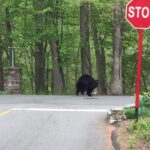
-
Suburban NJ has some prolific and big bears.
-
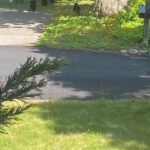
-
Bear and cubs. Photo Catherine Christ
The town police even fondly named one bruin “The Italian Bear.” Each night just after restaurants closed a fat bear would wander from its den, climb into the local Italian eatery’s dumpster, gorge itself, take a snooze, and come morning, climb out and go back to its secret den. Never hurt anyone.
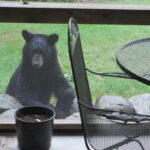
SRF took this pix of a bear peering in the window.
In rural New Hampshire, friends have had bears visit the yard and peek into the house through the windows frequently.
First Person Story

Picket fence was torn apart by a hungry spring-time bear.
Jackie and Peter Hull in Bedford, Virginia, shared this first-person story of the spring adventures with an unruly bear. “Well, I got up bright and early one spring morning, peeked out the bedroom window and what did I see? A smashed six-foot piece of picket fence, a broken spindle on the front porch, and a shepherd’s hook bent to the ground.
“Lucky me I brought the bird feeders in last night. So now I know I can’t feed the birds anymore this year. This is the second year running when on Mother’s Day last year, a bear came and smashed the spindles on the porch railing and a different six-foot piece of fence.
“Later we found bear tracks in the red Virginia clay bordering the flower bed on the outside of the fence. It left its muddy red prints on the fence and the steps going to the side door of the house!
“What to do but repair the fence again, wash the feeders, and put them in the basement? I have decided to store the leftover bird feed in a large bag in the freezer for next winter.
“I will miss my “bird buddies” but I don’t what a 250+ pound bear in my house either. So, words to the wise, the same ones the ranger gave me last year, ‘Bring your feeders in now.'”
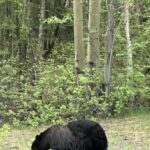
Alaskan Bear.
Back in Alaska, it is common even in suburban Anchorage neighborhoods to see a bear lumbering down a road. An Alaska-born, former Gazette editor spoke nonchalantly about bears and recess at schools. “We always had outdoor recess…except when a bear roamed the playground.”
Bears are about that is for sure!





























